









From the UCI Road World Championships Richmond 2015 website:
The Road World Championships (Worlds) is cycling’s pinnacle event, held annually in an international city as chosen by the Union Cycliste Internationale (UCI) through a competitive bidding process similar to the Olympic Games.
Worlds is a nine-day event, featuring 12 Championship races for Elite Men and Women, Under 23 Men and Junior Men and Women. It is a rare opportunity for the athletes to compete for their country, just as they do during the Olympic Games.
Ashland, Virginia—self-designated decades ago as the Center of the Universe—is a small town about 15 miles north of Richmond, home of Randolph-Macon College. Ashland is a railroad town predating the Civil War, originally built by executives of the RF&P Railroad.
However, that doesn’t stop the town being very bicycle friendly. Every nice weekend day cyclists swarm at Ashland Coffee and Tea, taking breaks during their enjoyment of rural Hanover County roads.
In the spirit of race week, Ashland’s Main Street Association invited merchants and residents to welcome cyclists and fans by decorating bicycles.
I want to share with you a sampling of what you can see if you walk around the bicycle gardens in the center of the Center of the Universe!
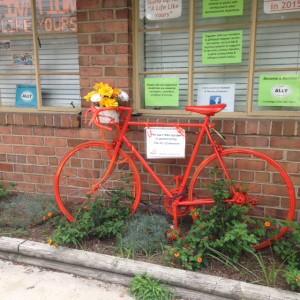

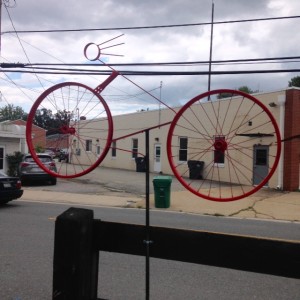
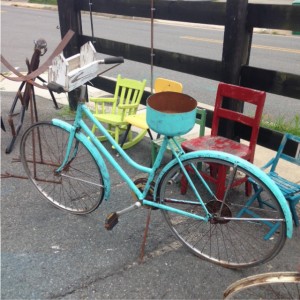
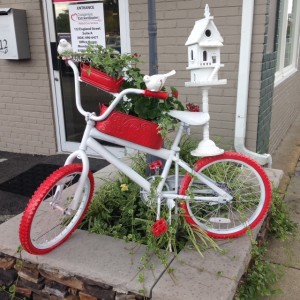
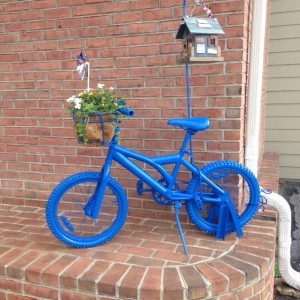
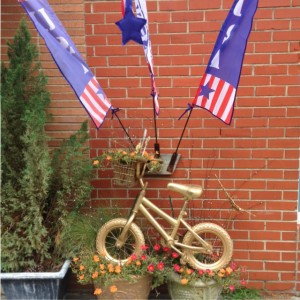
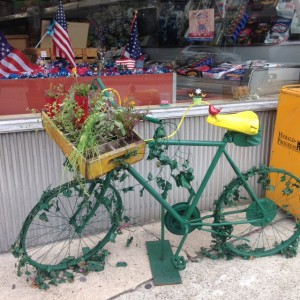
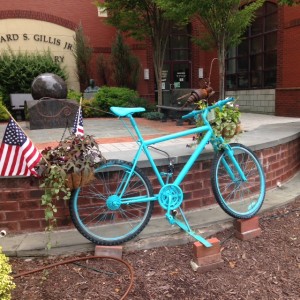
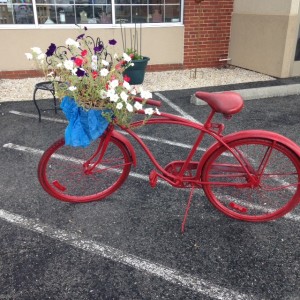
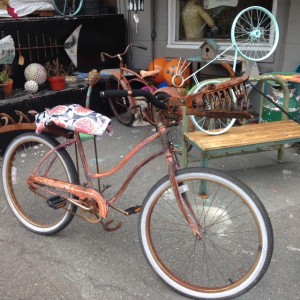
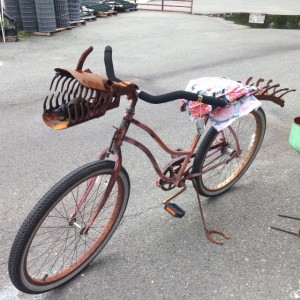
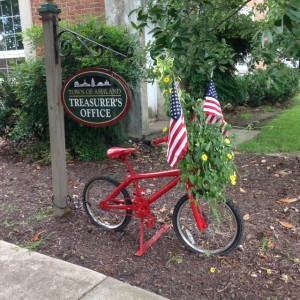
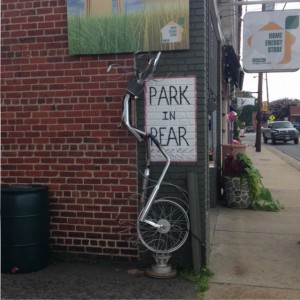
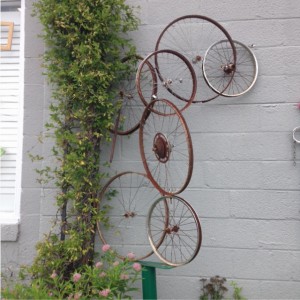
Ashland offers tourist information at the Train Station Visitor’s Center. You can get a bike garden scavenger hunt map there, as well as a self-guided walking tour of historic places.
And in downtown Ashland, you can get good food that does not come from a chain restaurant! (Of course, if chains are your thing, there are bunches around the I-95 exit, and along Rt. 1 and Rt. 54, very convenient.) There are antique stores and fun shops. Bottom line: something for everyone. Y’all come!
From the UCI Road World Championships Richmond 2015 website:
The Road World Championships (Worlds) is cycling’s pinnacle event, held annually in an international city as chosen by the Union Cycliste Internationale (UCI) through a competitive bidding process similar to the Olympic Games.
Worlds is a nine-day event, featuring 12 Championship races for Elite Men and Women, Under 23 Men and Junior Men and Women. It is a rare opportunity for the athletes to compete for their country, just as they do during the Olympic Games.
When my interest is piqued, of course I turn to research. A friend told me that the gift shop at Lewis Ginter Botanical Gardens has two books on the history of bicycle racing in Richmond. True confession: I did not buy them—but you might want to. In the meantime, I did go on-line. As usual, Wikipedia has a lengthy article on the history of the bicycle. You might also be interested in visiting the Smithsonian Institute website, for their series America on the Move. These include pictures. Also, A Pictorial History of the Evolution of the Bicycle has great pictures
I’ll share with you some of what I learned. First of all, the immediate ancestor of the bicycle was the Draisine, also called a Velocipede, Hobby Horse or Swift-Walker. It was designed by Baron von Drais in 1817 and looked like a bicycle, but had no pedals. So one moved by walking along, feet on the ground, while seated. It was made of wood, with iron bound wheels, and weighed nearly 50 pounds. Even so, speeds of eight miles per hour were feasible.
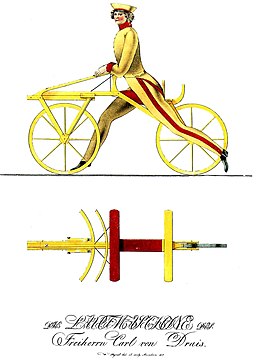
Although a two-wheeled bicycle with pedals may have been created as early as 1839, Pierre Lallement filed the earliest and only patent for a pedal-driven bicycle, in the US in 1866.

Soon after, in 1869, a pedal-bicycle was invented for ladies.
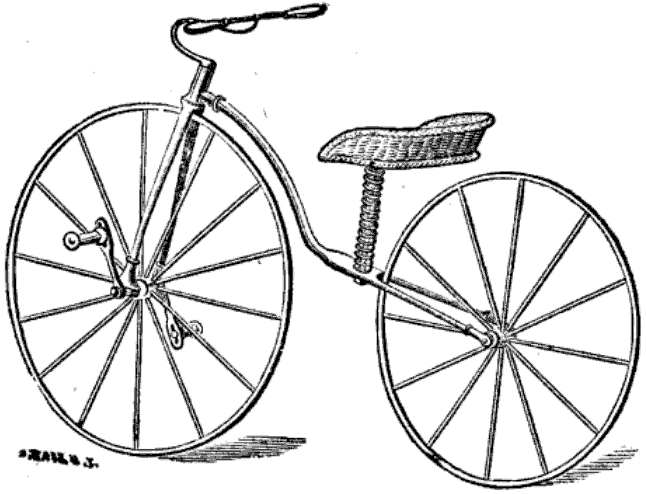
The next major development came in 1885, when John Kemp Starley created—but never patented—the first successful “safety bicycle.” His improvements included a steerable front wheel, wheels of equal size, and a chain drive to the rear wheel. Bicycles became very popular for both work (commuting, deliveries, etc.) and pleasure uses. In 1895, Chicago put its mailmen on bicycles. The safety bicycle was the first bicycle suitable for women.


As far as I’m concerned, developments since then are all just tweaking! As the automobile became the preferred mode of individual transportation in the US, bicycles have been taken over for pleasure and exercise. As of the 1970s, cycling was the nation’s leading outdoor recreation. Still, bicycle messengers flourish in major US cities. In other parts of the world, the bicycle is still the “workhorse” of preference. In the People’s Republic of China, the Flying Pigeon was the government approved form of transportation, considered essential for every household, along with a sewing machine and a watch. In the 1970s, the post-Mao leader Deng Xiaoping defined prosperity as “a Flying Pigeon in every household”—which reminds me that in the presidential campaign of 1928, a circular published by the Republican Party claimed that if Herbert Hoover won there would be a chicken in every pot. A lucky duck. True confession: my mind works in mysterious ways.
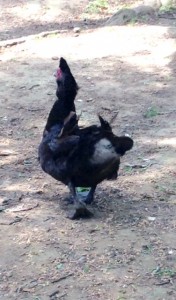
And that seems as good a place as any to end this!
From the UCI Road World Championships Richmond 2015 website:
The Road World Championships (Worlds) is cycling’s pinnacle event, held annually in an international city as chosen by the Union Cycliste Internationale (UCI) through a competitive bidding process similar to the Olympic Games.
Worlds is a nine-day event, featuring 12 Championship races for Elite Men and Women, Under 23 Men and Junior Men and Women. It is a rare opportunity for the athletes to compete for their country, just as they do during the Olympic Games.
The fun begins! No doubt we will hear and read a lot about the races in the week ahead. Your challenge for this week is to consider the following writing prompts and write a story—or more than one! Fiction, genre, style, none of that matters to me. Just be sure bicycles are a central element. Please share what you create!
Write a story in which a bicycle is central to love and/or romance.
Write about how and why this bicycle is on the roof of a dry cleaning business.
Write a story about biking under the influence. (My preference is that the message be it isn’t a good thing to do—but that isn’t a rule!)
Write about someone who commutes by bicycle.
Write about bicycles that are able to leap tall buildings at a single bound!
And in the spirit of Stephen King (a write-by-the-seat-of-his-pants author who starts with a single question): What if a cyclist on a country road suddenly realizes that his bicycle is turning to jelly? What if bicycles could reproduce the way (choose an animal) do? What if bicycles had secret night lives? Or start with your own What if...?
Enjoy!
Not that I am a cycling enthusiast, but any event this big piques my interest. Some weeks ago, when I first became aware of the upcoming races, I started noticing bicycles—and they are everywhere! Did you ever count how many clutches of bicycles are fastened to motor vehicles?
Although the Virginia DOT says that all vehicular laws apply to bicycles, clearly this isn’t the case with parking.
Also, DUI statutes don’t apply to bicycles in Virginia. Although one can be charged with DUI/DWI for drunk bicycling in 22 states, Virginia isn’t among them. Still, in my opinion, one would be stupid to do it. The person most likely to be injured is the cyclist, but think of the trauma to family, and to the motorist who might have killed someone. It’s like riding without a helmet: just because you can doesn’t mean you should!
But I digress. I was talking about bicycles being everywhere, and used for all sorts of purposes. When I was a Nimrod this summer, I intentionally saved this picture for now.
And perhaps the sweetest picture of all—
Check out the UCI Road World Championship website to learn more.

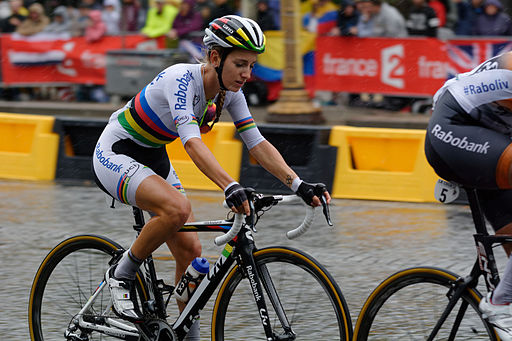
By youkeys (La Course by Le Tour de France 2015) [CC BY 2.0], via Wikimedia Commons